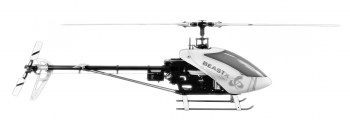Manuals:MBPlusFblV5:Setupmenu J/de: Difference between revisions
Shornstein (talk | contribs) No edit summary |
Shornstein (talk | contribs) No edit summary |
||
| Line 3: | Line 3: | ||
<br /> | <br /> | ||
At SETUP MENU point J we adjust the internal servo throw so that the AR7210BX receiver has a reference on how far it must move the servos when controlling the helicopter. To set the throw you align one rotorblade on the longitudinal axis (in parallel to the tail boom) and measure the cyclic pitch with a digital pitch gauge on this rotorblade. (You can do this from the front or from the rear!)<br /> | |||
{| | {| | ||
|- | |- | ||
| Line 12: | Line 10: | ||
|}<br /> | |}<br /> | ||
<br /> | <br /> | ||
Initially you should see 0 degrees of pitch now (in case you did the setup at SETUP MENU point H properly!). Then you switch to the adjustment position. The system will give some amount of pitch which you measure again. This time you should see 6.0 degrees (+ or - is not of importance). If not, increase or decrease the swash throw accordingly.<br /> | |||
<br /> | |||
The color of the Status LED gives some indication whether you rotorhead geometry is well suited for flybarless usage or not. Ideally the Status LED on the device should be blue when in 6.0 degress position. If it isn't, this means your servo movements cause very much pitch deflection on the rotorhead. This can be bad for the performance as the system may tend to oversteer and overreact very easily. If you have problem with finding correct gain settings or overcompensation later in flight, the cause may be found here. To solve this you can change geometry by moving the linkage balls on the servo horns closer to the servo center.<br /> | |||
<br /> | <br /> | ||
{|cellpadding="4" cellspacing="0" border="1" | {|cellpadding="4" cellspacing="0" border="1" | ||
| style="width:100px; text-align:left;" | '''Status-LED''' || style="text-align:center;" | ''' | | style="width:100px; text-align:left;" | '''Status-LED''' || style="text-align:center;" | '''Cyclic throw''' | ||
|- | |- | ||
| style="color:white; background-color:#CC66CC" | | | style="color:white; background-color:#CC66CC" | purple || not good | ||
|- | |- | ||
|style="color:white; background-color:#FF3300" | | |style="color:white; background-color:#FF3300" | red || OK | ||
|- | |- | ||
| style="color:white; background-color:#0066FF" | | | style="color:white; background-color:#0066FF" | blue || perfect! | ||
|}<br /> | |}<br /> | ||
<br /> | <br /> | ||
Revision as of 09:59, 19 July 2018
At SETUP MENU point J we adjust the internal servo throw so that the AR7210BX receiver has a reference on how far it must move the servos when controlling the helicopter. To set the throw you align one rotorblade on the longitudinal axis (in parallel to the tail boom) and measure the cyclic pitch with a digital pitch gauge on this rotorblade. (You can do this from the front or from the rear!)

|

|
Initially you should see 0 degrees of pitch now (in case you did the setup at SETUP MENU point H properly!). Then you switch to the adjustment position. The system will give some amount of pitch which you measure again. This time you should see 6.0 degrees (+ or - is not of importance). If not, increase or decrease the swash throw accordingly.
The color of the Status LED gives some indication whether you rotorhead geometry is well suited for flybarless usage or not. Ideally the Status LED on the device should be blue when in 6.0 degress position. If it isn't, this means your servo movements cause very much pitch deflection on the rotorhead. This can be bad for the performance as the system may tend to oversteer and overreact very easily. If you have problem with finding correct gain settings or overcompensation later in flight, the cause may be found here. To solve this you can change geometry by moving the linkage balls on the servo horns closer to the servo center.
| Status-LED | Cyclic throw |
| purple | not good |
| red | OK |
| blue | perfect! |
Einstellung am Gerät
Zu Beginn ist die Status LED aus, die Taumelscheibe steht waagrecht und die Rotorblätter sollten 0 Grad Pitchanstellwinkel haben. Befestige eine Pitcheinstelllehre am Blattgriff oder Rotorblatt und kalibriere diese auf 0. Tippe dann den Roll-Steuerknüppel einmal kurz an, dadurch fährt die Taumelscheibe in Messposition. Prüfe jetzt, ob die Pitchlehre +-6.0 Grad Pitch anzeigt und vergrößere/reduziere den Winkel (falls nötig) durch Antippen oder Halten des Heck-Steuerknüppels (links = reduzieren, rechts = vergrößern). Zwischen der Mess- und Neutralposition kann dabei beliebig oft umgeschaltet werden. Drücke dann kurz auf den Knopf um zum nächsten Einstellpunkt zu wechseln.
Einstellung über StudioXm
Zu Beginn steht die Taumelscheibe waagrecht und die Rotorblätter sollten 0 Grad Pitchanstellwinkel haben. Befestige eine Pitcheinstelllehre am Blattgriff oder Rotorblatt und kalibriere diese auf 0. Wähle dann Messen, so dass die Taumelscheibe in Messposition fährt. Prüfe jetzt, ob die Pitchlehre +-6.0 Grad Pitch anzeigt und vergrößere/reduziere den Wert (falls nötig) mit + und - oder über das Drehrad. Zwischen der Mess- und Neutralposition kann dabei beliebig oft umgeschaltet werden.